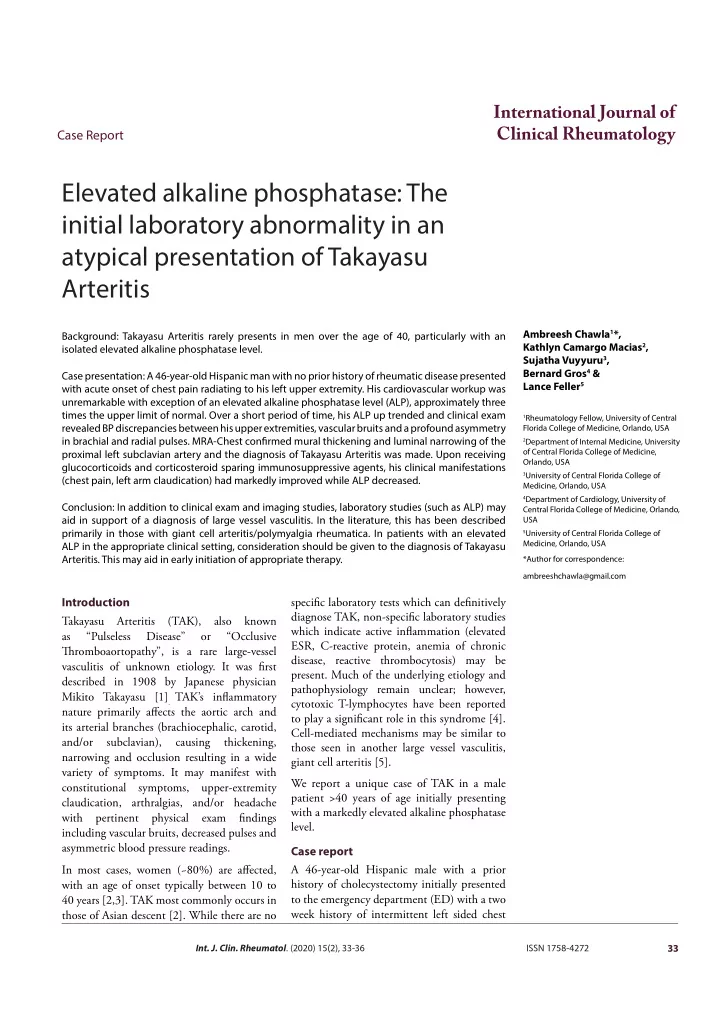

International Journal of Clinical Rheumatology Case Report Elevated alkaline phosphatase: The initial laboratory abnormality in an atypical presentation of Takayasu Arteritis Ambreesh Chawla 1 *, Background: Takayasu Arteritis rarely presents in men over the age of 40, particularly with an Kathlyn Camargo Macias 2 , isolated elevated alkaline phosphatase level. Sujatha Vuyyuru 3 , Bernard Gros 4 & Case presentation: A 46-year-old Hispanic man with no prior history of rheumatic disease presented Lance Feller 5 with acute onset of chest pain radiating to his left upper extremity. His cardiovascular workup was unremarkable with exception of an elevated alkaline phosphatase level (ALP), approximately three times the upper limit of normal. Over a short period of time, his ALP up trended and clinical exam 1 Rheumatology Fellow, University of Central revealed BP discrepancies between his upper extremities, vascular bruits and a profound asymmetry Florida College of Medicine, Orlando, USA in brachial and radial pulses. MRA-Chest confjrmed mural thickening and luminal narrowing of the 2 Department of Internal Medicine, University of Central Florida College of Medicine, proximal left subclavian artery and the diagnosis of Takayasu Arteritis was made. Upon receiving Orlando, USA glucocorticoids and corticosteroid sparing immunosuppressive agents, his clinical manifestations 3 University of Central Florida College of (chest pain, left arm claudication) had markedly improved while ALP decreased. Medicine, Orlando, USA 4 Department of Cardiology, University of Conclusion: In addition to clinical exam and imaging studies, laboratory studies (such as ALP) may Central Florida College of Medicine, Orlando, aid in support of a diagnosis of large vessel vasculitis. In the literature, this has been described USA primarily in those with giant cell arteritis/polymyalgia rheumatica. In patients with an elevated 5 University of Central Florida College of Medicine, Orlando, USA ALP in the appropriate clinical setting, consideration should be given to the diagnosis of Takayasu Arteritis. This may aid in early initiation of appropriate therapy. *Author for correspondence: ambreeshchawla@gmail.com Introduction specifjc laboratory tests which can defjnitively diagnose TAK, non-specifjc laboratory studies Takayasu Arteritis (TAK), also known which indicate active infmammation (elevated as “Pulseless Disease” or “Occlusive ESR, C-reactive protein, anemia of chronic Tiromboaortopathy”, is a rare large-vessel disease, reactive thrombocytosis) may be vasculitis of unknown etiology. It was fjrst present. Much of the underlying etiology and described in 1908 by Japanese physician pathophysiology remain unclear; however, Mikito Takayasu [1] . TAK’s infmammatory cytotoxic T-lymphocytes have been reported nature primarily afgects the aortic arch and to play a signifjcant role in this syndrome [4]. its arterial branches (brachiocephalic, carotid, Cell-mediated mechanisms may be similar to and/or subclavian), causing thickening, those seen in another large vessel vasculitis, narrowing and occlusion resulting in a wide giant cell arteritis [5]. variety of symptoms. It may manifest with We report a unique case of TAK in a male constitutional symptoms, upper-extremity patient >40 years of age initially presenting claudication, arthralgias, and/or headache with a markedly elevated alkaline phosphatase with pertinent physical exam fjndings level. including vascular bruits, decreased pulses and asymmetric blood pressure readings. Case report In most cases, women (~80%) are afgected, A 46-year-old Hispanic male with a prior with an age of onset typically between 10 to history of cholecystectomy initially presented to the emergency department (ED) with a two 40 years [2,3]. TAK most commonly occurs in those of Asian descent [2]. While there are no week history of intermittent left sided chest Int. J. Clin. Rheumatol . (2020) 15(2), 33-36 ISSN 1758-4272 33
Case Report Chawla, et al. pain radiating to his left upper extremity with associated claudication. Tie patient did not have any previous personal or family history of rheumatologic disease. He denied any joint pain, swelling or discomfort. In the ED, Review of Systems (ROS) was positive for generalized fatigue with decreased energy over the past two weeks. ROS was negative for jaw claudication, scalp tenderness, temporal headaches or changes in vision. Vital signs were stable and the patient was noted to have normal BNP , D-Dimer, and electrolytes. Further diagnostics revealed an unremarkable EKG and normal appearing chest x-ray. Serial cardiac enzymes did not show any evidence of myocardial injury. Tie only laboratory abnormality detected was an elevated Alkaline Phosphatase (ALP) Figure 2. MRA Chest +/- contrast demonstrating mural of 392 IU/L (~3x upper limit of normal). Due to thickening and luminal narrowing of the proximal left a recent normal cardiac stress test, a Coronary CT subclavian artery. Angiography (CCTA) was instead pursued. Tie CCTA demonstrated a calcium score of 0 without evidence of coronary artery plaque or stenosis, however mild thickening of the ascending thoracic aorta wall without dissection was noted. Tie patient received nitroglycerin and narcotic pain medications and was subsequently discharged. During outpatient follow-up fjve days later, the patient continued to have chest discomfort with left arm claudication. On physical exam, the patient had a wide disparity in blood pressures between his upper extremities (RUE: 162/62 mmHg & LUE: 118/84 mmHg) and a vascular bruit was auscultated in the left infraclavicular area. Additionally, a profound asymmetry in brachial and radial pulses were appreciated. At this time, the patient underwent workup for aortitis. Labs Figure 3. MRA Chest +/- contrast (coronal view) demonstrating revealed an elevated ALP of 481 IU/L with elevated thickening and luminal narrowing of the proximal left subclavian artery. markers of infmammation (ESR 19 mm/hr and C-reactive protein 11.8 mg/L) with ALP iso-enzymes elevated for Figure 1. MRA Chest +/- contrast demonstrating mural thickening and luminal narrowing of the proximal left Figure 4. CT-Angiogram of neck demonstrating moderate subclavian artery. stenosis involving the origin of the left subclavian artery. 34 Int. J. Clin. Rheumatol. (2020) 15(2)
Recommend
More recommend